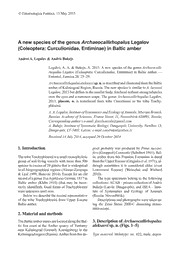
A new species of the genus Archaeocallirhopalus Legalov (Coleoptera: Curculionidae, Entiminae) in Baltic amber PDF
Preview A new species of the genus Archaeocallirhopalus Legalov (Coleoptera: Curculionidae, Entiminae) in Baltic amber
©EntomologicaFennica.13May2015 Anew species of the genus Archaeocallirhopalus Legalov (Coleoptera: Curculionidae, Entiminae) in Baltic amber AndreiA.Legalov&AndrisBukejs Legalov, A. A. &Bukejs, A. 2015:Anew speciesofthegenusArchaeocalli- rhopalus Legalov (Coleoptera: Curculionidae, Entiminae) in Baltic amber. — Entomol.Fennica26:25–29. Archaeocallirhopalusalekseevisp.n.isdescribedandillustratedfromtheBaltic amberofKaliningradRegion,Russia.ThenewspeciesissimilartoA.larssoni Legalov,2013butdiffersinthesmallerbody,foreheadwithoutstrongtubercles overtheeyesandanarrowerscape.ThegenusArchaeocallirhopalusLegalov, 2013, placem. n. is transferred from tribe Cneorhinini to the tribe Trachy- phloeini. A.A.Legalov,InstituteofSystematicsandEcologyofAnimals,SiberianBranch, RussianAcademyofSciences,FrunzeStreet,11,Novosibirsk630091,Russia; Correspondingauthor’se-mail:[email protected] A.Bukejs,InstituteofSystematicBiology,DaugavpilsUniversity,Vienïbas13, Daugavpils,LV-5401,Latvia;e-mail:[email protected] Received14July2014,accepted29October2014 1.Introduction posit probably was produced by Pinus succini- fera(Goeppert)Conwentz(Schubert1961).Bal- ThetribeTrachyphloeiniisasmallmonophyletic ticamberfromthisPrussianFormationisdated groupofsoil-livingweevilswithmorethan500 fromtheUpperEocene(Grigjalisetal.1971),al- speciesinexcessof20generathatiswidespread though sometimes it is considered older (even inallbiogeographicalregions(Alonso-Zarazaga Lowermost Eocene) (Weitschat and Wichard &Lyal1999,Borovec2014).Exceptforanold 2010). recordofagenusTrachyphloeusGermar,1817in The type specimens belong to the following Baltic amber (Klebs 1910) (that may be incor- collections:ACAB–privatecollectionofAndris rectlyidentified),fossilformsofTrachyphloeini Bukejs (Latvia: Daugavpils), and ISEA– Insti- wereunknownuntilnow. tute of Systematics and Ecology of Animals Belowwedescribethesecondrepresentative (Russia:Novosibirsk). of the tribe Trachyphloeini from Upper Eocene Descriptionsandphotographsweretakenus- Balticamber. ing the Zeiss Stemi 2000-C dissecting stereo- microscope. 2.Materialandmethods TheBalticamberminesarelocatedalongtheBal- 3.DescriptionofArchaeocallirhopalus tic Sea coast at the Amber quarry of Yantarny alekseevisp.n.(Figs.1–5) near Kaliningrad (formerly Koenigsberg) in the Kaliningradregion(Russia).Amberfromthisde- Type material. Holotype: no. 022, male, depos- 26 Legalov&Bukejs (cid:127) ENTOMOL.FENNICAVol.26 Fig.1.Lateral(right)viewofArchaeocallirhopalus alekseevisp.n.(holotype).Scalebar=1mm. itedinACAB.Paratype:no.BA2012/13,female, depositedinISEA. Diagnosis. This new species is similar to A.larssoniLegalov,2013butdiffersinasmaller Fig.2.LateralviewofheadofArchaeocallirhopalus alekseevisp.n.(holotype).Scalebar=1mm. body,foreheadwithoutstrongtuberclesoverthe eyesandanarrowerscape. Description.Male.Bodylength(withoutros- trum)3.3mm;rostrumlength0.5mm. Body black, with short, wide, very dense, grey-browncontiguousscales,appearingsilvery shiny due to the presence of cavities between specimenandinternalsurfaceofitsimpression. Head.Rostrumshort,wide,0.8timesaslong aspronotum,equalinlengthandwidth,withal- most straight sides, nearly straight, densely punctate,withtwoweakstriaeformingangleat base,epistomusalmostbare,pterygiadeveloped; scrobes visible dorsally, directed toward eyes, base with weak transverse stria; forehead wide, weaklyflattened,coarselypunctate,withmedian stria but without tubercles on either side; eyes small, rounded, weakly convex; vertex weakly flattened, punctate; temples short, 0.5 times as long as eye, punctate; antennae inserted at first thirdofrostrumlaterally;antennaelong,reaching elytralhumeri;scape3.7timeslongerthanwidth, with dense contiguous and sparse decumbent scales, almost equal in length to flagellum; antennomeres conical, with dense scales and sparselongdarksemierectsetae;1stantennomere 2.2timeslongerthanwide,0.2timesaslongand 0.4timesaswideasscape;2ndantennomere2.5 timeslongerthanwide,0.9timesaslongand0.8 Fig.3.DorsalviewofArchaeocallirhopalusalekseevi timesaswideas1stantennomere;3rdantennomere sp.n.(paratype).Scalebar=1mm. ENTOMOL.FENNICAVol.26 (cid:127) AnewcurculionidspeciesfromBalticamber 27 Fig.4.Lateral(left)viewofArchaeocallirhopalus alekseevisp.n.(paratype).Scalebar=1mm. 1.4timeslongerthanwide,0.5timesaslongand 0.9 times as wide as 2nd antennomere; 4th – 6th antennomeres subequal to 3rd antennomere; 7th antennomere1.3timeslongerthanwide,almost equal in length and 1.1 times as long as 6th antennomere;clubcompact,0.4timesaslongas Fig.5.VentralviewofArchaeocallirhopalusalekseevi flagellum,1.8timeslongerthanwide,withfused sp.n.(paratype).Scalebar=1mm. antennomeres,weaklyacuminate. Pronotum. Pronotum transverse, slightly metacoxa; 3rd and 4th ventrites short, equal in shorter than elytral base; disk narrowed at apex length; 3rd ventrite 0.4 times as long as 2nd andatbase,denselypunctate,withweaklongitu- ventrite; 5th ventrite 3.2 times as long as 4th dinalbarelineandweakocularlobes. ventrite. Mesonotum.Scutellumreduced. Legs.Legslong,withdense,broadscalesand Elytra. Elytra weakly elongate and convex, contiguoussparseelongatesetae;femoraweakly 3.6timesaslongaspronotum;greatestwidthbe- clavate,withoutteeth;profemurlength/widthra- hindmiddle;humericompletelyflattened;punc- tio 2.7; mesofemur length/width ratio 2.9; turedstriaeregularanddistinct;puncturesoval, metafemurlength/widthratio3.6;trochantercon- small and dense; intervals weakly convex, 4.0– ical;tibiaealmoststraight,weaklyflattened,wid- 7.0 times as wide as striae, with middle row of ened at apices, with apical dark setose fringe; shortdecumbentnarrowscales. metatibial corbels closed; protibia length/width Thorax. Prosternum punctate; precoxal part ratio 4.2; metatibia length/width ratio 5.1; tarsi ofprosternumweaklyelongate,equalinlengthto long,withthicklighterectsetaedorsally;1stand procoxalength;procoxalcavitiesround,joined; 2nd tarsomeres triangular; 3rd tarsomere widely postcoxalpartofprosternumshort,0.4timesas bilobed;5thtarsomereelongate;clawslarge,free, long as procoxa length; mesocoxal cavities without teeth; mesotarsi: 1st tarsomere barely rounded,narrowlyseparated;metasternumshort, wider than long; 2nd tarsomere 0.8 times longer 0.4 times as long as metacoxa length, convex, thanwide,0.8timesaslongandwideas1sttarso- punctate;metepisternumnarrow,barelyvisibile. mere; 3rd tarsomere 0.8 times longer than wide, Abdomen. Abdomen flattened in middle; 1.4timesaslongand1.3timesaswideas2ndtar- metaventralprocessaswideastransversediame- somere;5thtarsomere3.6timeslongerthanwide, ter of metacoxa; 1st and 2nd ventrites elongate, 1.4timesaslongand0.3timesaswideas3rdtar- equal in length; 1st ventrite 1.2 times as long as somere. 28 Legalov&Bukejs (cid:127) ENTOMOL.FENNICAVol.26 Female. Body length (without rostrum) 3.3 4.Discussion mm;rostrumlength0.6mm. Head.Rostrum0.7timesaslongaspronotum, Some representatives of the tribe Cneorhinini equal in length and width; temples 0.7 times as (particularlywithsmallbodies)aresimilartorep- longaseye. resentativesofthetribeTrachyphloeiniandtheir Pronotum. Pronotum 1.4 times longer than taxonomic position is sometimes interpreted in- wideatapex,0.7timeslongerthanwideinmid- correctly (Zherikhin&Egorov1991).Thetribe dle,0.8timeslongerthanwideatbase. Trachyphloeiniischaracterizedbyclosedmeta- Elytra.Elytra3.1timesaslongaspronotum, tibialcorbels,andthetribeCneorhininiischarac- 2.1timeslongerthanwideatapex,1.5timeslon- terizedbyopenmetatibialcorbels(verticallydi- ger than wide in middle, 2.9 times longer than vided into two parts) as Borovec (2009) noted. wideatapicalfourth;greatestwidthbehindmid- This character was poorly studied in the genus dle;intervals4.5–6.7timesaswideasstriae. Archaeocallirhopalus (Legalov 2013). For this Thorax.Precoxalpartofprosternum0.9times study,metatibialcorbelswereobservedindetail as long as procoxa length; postcoxal part of intheholotypeofArchaeocallirhopaluslarssoni prosternum0.6timesaslongasprocoxalength. Legalov, 2013 and the type specimens of A. Abdomen. 1st and 2nd ventrites weakly con- alekseevisp.n.Weconcludedthatbothspecies vex,equalinlength;1stventrite1.1timesaslong haveclosedcorbelsonthemetatibiae,andthere- asmetacoxalength;3rd–5thventritesflattened;3rd fore this genus belongs to the tribe Trachy- and 4th ventrites equal in length; 3rd ventrite 0.2 phloeini.ThegenusArchaeocallirhopalusdiffers timesaslongas2ndventrite;5thventrite3.3times from the genus Cathormiocerus Schoenherr, aslongas4thventrite. 1842byhavingtheanteriormarginoftheprono- Legs. Profemur length/width ratio 2.7; tum with ocular lobes and the metaventral pro- mesofemur length/width ratio 3.4; metafemur cess as wide as the transverse diameter of the length/widthratio3.2;protibialength/widthratio metacoxae.Itcanbedifferentiatedfromthegenus 7.0; mesotibia length/width ratio 7.0; metatibia PseudocneorhinusRoelofs,1873bytheweakoc- length/width ratio 5.4; mesotarsi: 1st tarsomere ularlobesandfreeclaws. Archaeocallirhopalus 1.6 times longer than wide; 2nd tarsomere 0.7 is habitually similar to the genus Callirhopalus timeslongerthanwide,0.6timesaslongand1.4 Hochhuth, 1851 (Cneorhinini) but differs in timesaswideas1sttarsomere;3rdtarsomere0.7 closedmetatibialcorbelsandapronotumwithoc- timeslongerthanwide,1.4timesaslongand1.4 ularlobes. timesaswideas2ndtarsomere;5thtarsomere3.0 WeevilsofthesubfamilyEntiminaearequite timeslongerthanwide,1.7timesaslongand0.4 abundantintheBalticamber.Tenspeciesfrom6 timesaswideas3rdtarsomere;metatarsi:1sttarso- genera of the tribes Polydrusini, Anypotactini, mere 1.4 times longer than wide; 2nd tarsomere Naupactini,SciaphiliniandTrachyphloeinihave 0.9timeslongerthanwide,0.7timesaslongand been described (Yunakov and Kirejtshuk 2011, 1.1timesaswideas1sttarsomere;3rdtarsomere Legalov 2012, 2013). Entiminae comprise ap- 0.8timeslongerthanwide,1.4timesaslongand proximatelyonethirdoftheBalticamberCurcu- 1.5timesaswideas2ndtarsomere;5thtarsomere lionidae.ThegeneraSitonaGermar,1817(Sito- 3.8timeslongerthanwide,1.5timesaslongand nini)andPhyllobiusGermar,1824(Phyllobiini) 0.3timesaswideas3rdtarsomere. havealsobeenrecorded(Klebs1910). Type locality and type strata. Amber mines locatedalongtheBalticSeacoastandYantarny Acknowledgements.TheauthorsthankDr.AlexanderS. Amber quarry near Kaliningrad (formerly Konstantinov (National Museum of Natural History, Washington,U.S.A.)forlinguisticsuggestionsfortheear- Koenigsberg),Kaliningradregion,Russia;Upper lierversionofthemanuscript,andDr.VitaliiI.Alekseev Eocene,PrussianFormation. (Kaliningrad,Russia)forconstructiveadvice.Thestudy Etymology. The name of this new species is waspartiallysupportedbytheFederalFundamentalScien- dedicated to our dear colleague, Dr. Vitalii I. tific Research Programme for 2013–2020, Project No. Alekseev(Kaliningrad,Russia). VI.51.1.7. ENTOMOL.FENNICAVol.26 (cid:127) AnewcurculionidspeciesfromBalticamber 29 References Legalov,A.A.2013:Newandlittleknownweevils(Cole- optera:Curculionoidea)fromthePaleogeneandNeo- gene.—HistoricalBiology25(1):59–80. Alonso-Zarazaga,M.A.&Lyal,C.H.C.1999:Aworld catalogueoffamiliesandgeneraCurculionoidea(In- Schubert,K.1961:NeueUntersuchungenüberBauund secta:Coleoptera)(exceptingScolytidaeandPlatypo- Leben der Bernsteinkiefern (Pinus succinifera didae).Entomopraxis,Barcelona.315pp. (Conw.)emend.).—BeihefteGeologischenJahrbuch Borovec,R.2009:RevisionofthePalaearcticsupraspeci- 45:1–149. fictaxaofthetribeTrachyphloeini(Coleoptera:Cur- Weitschat,W.&Wichard,W.2010:Balicamber:80–115. culionidae:Entiminae).—Klapalekiana45:1–97. —In:Penney,D.(ed.),Biodiversityoffossilsinam- Borovec,R.2014:StudyonTrachyphloeinioftheOriental ber from the major world deposits. Siri Scientific Region (Coleoptera: Curculionidae: Entiminae). — Press,Manchester.304pp. StudiesandReports.TaxonomicalSeries10(1):1–39. Yunakov,N.N.&Kirejtshuk,A.G.2011:Newgenusand Grigjalis,A.A.,Baltakis,V.V.&Katinas,V.1971:Stratig- speciesofbroad-nosedweevilsfromBalticamberand raphyofPaleogenedepositsintheBaltics.—Izvestija notesonfossilsofthesubfamilyEntiminae(Coleop- Akademii Nauk SSSR. Serija Geologicheskaja 3: tera,Curculionidae).—ZooKeys160:73–96. 107–116. Klebs,R.1910:ÜberBernsteinschlüsseimallgemeinund Zherikhin,V.V.&Egorov,A.B.1991:Beetles-weevils die Coleopteren meiner Bernsteinsammlung. — (Coleoptera, Curculionidae) of Far Eastern USSR Schriften Physikalisch-Ökonomischen Gesellschaft (surveyofsubfamilieswithdescriptionofnewtaxa). zuKönigsbergimPrussia51(3):217–242. —AkademijanaukSSSR,Dal’nevostochnoeOtdele- Legalov,A.A.2012:NewCurculionoidbeetles(Coleop- nie, Biologo-Pochvennyj Institut, Vladivostok. 164 tera:Curculionoidea)fromtheBalticamber.—Pale- pp. ontologicalJournal46(3):262–272.
